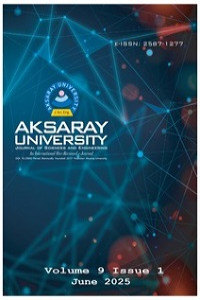Optimization of Concrete Based on Scheffe’s Model Using Crushed Glass as Partial Replacement for Fine Aggregate
Abstract
This study developed a mathematical model for optimizing the 28-day compressive strength of concrete containing crushed glass and Bida Natural Gravel, based on Scheffe's simplex theory. Using a total of 30 mix ratios, 90 concrete cubes were cast to validate the model. Fifteen mix ratios derived from simplex lattice points were used to calculate model coefficients, while the remaining 15 pseudo-random mixes served as control points. The model’s predictions were statistically validated using the Fischer test, demonstrating adequacy with a 95 percent confidence level. Optimization via MATLAB revealed an ideal 28-day compressive strength of 36.83 MPa, corresponding to an optimal mix ratio—0.4739:1:0.6854:0.1952:1.7612 for water, cement, sand, crushed glass, and BNG. This model enables prediction of mix ratios for desired strengths of concrete containing 0 percent to 25 percent crushed glass.
Keywords
Crushed glass Fine aggregate Scheffe’s optimization model Simplex design Compressive strength
References
- [1] Rakshvir, M., & Barai, S. V. (2006). Studies on Recycled Aggregates-Based Concrete, Waste Management & Research, 24 (3), 225–233.
- [2] Park, S. B., Lee, B. C., & Kim, J. H. (2004). Studies on mechanical properties of concrete containing waste glass aggregate, Cement and Concrete Research, 34 (12), 2181–2189.
- [3] Shayan, A., & Xu, A. (2004). Value-Added Utilization of Waste Glass in Concrete, Cement and Concrete Research, 34 (1), 81–89.
- [4] Corinaldesi, V., Gnappi, G., Moriconi, G., & Montenero, A. (2005). Reuse of Ground Waste Glass as Aggregate for Mortars, Waste Management, 25 (2), 197–201.
- [5] Chen, C. H., Wu, J. K., & Yang, C. C. (2006). Waste E-Glass Particles Used in Cementitious Mixtures, Cement and Concrete Research, 36 (3), 449–456.
- [6] Metwally, I. M. (2007). Investigations on the Performance of Concrete Made with Blended finely Milled Waste Glass, Advances in Structural Engineering, 10 (1), 47–53
- [7] Rajasekeran, S. (2005). Optimization mix of High-Performance Concrete by Evolution Strategies Combined with Neural Network, Indian Journal of Engineering & Material Science, 13, 7-17.
- [8] Chen, H. S., Sun, W., & Stroven, P. (2003). Prediction of compressive strength and optimization of mixture proportioning in ternary cementitious systems, Eng. Mater. Struct., 36(6), 396–401.
- [9] Nwakonobi, T. U., & Osadebe, N. N. (2008). Development of an optimization model for mix proportion of clay-rice husk-cement mixture for animal buildings, Agricultural Eng. Int.: CIGR E-Journal, Manuscript BC 08 007, Vol. X.
- [10] Anyaogu, L. & Ezeh, J. C. (2013). Optimization Compressive strength of fly ash blended Cement Concrete Using Scheffe’s Simplex Theory, Academic Research Natural and Applied Sciences, (4)2,2223-9553.
- [11] Simon, M. (2003). Concrete mixture optimization using statistical method, Final Report Federal Highway Administration. Maclean VA, 120-127.
- [12] Ezeh, J. C., & Ibearugbulem, O. M. (2009). Application of Scheffe’s model in optimization of compressive strength of Rivers Stone Aggregate concrete, Int. J. Natural and Applied Sciences, 5(4), 303-308.
- [13] Osadebe, N. N. (2003). Generalized mathematical modeling of compressive strength of normal concrete as a multi-variant function of the properties of its constituent components. University of Nigeria Nsukka.
- [14] Arimanwa, J. I., Onwuka, D. O., Arimanwa, M. C., & Onwuka, U. S. (2012). Prediction of the Compressive Strength of Aluminum Waste–Cement Concrete Using Scheffe’s Theory, Journal of Materials in Civil Engineering, 24, 177-183.
- [15] Kalantari, B., Mafian, S., & Huat, B. B. K. (2009). RC Concrete Versus Conventional Concrete Pavement, Contemporary Engineering Science, 2(3), 139-148.
- [16] Scheffe, H. (1958). Experiments with mixture, Journal of the Royal Statistical Society, 20, 344 – 360.
- [17] Simon, M. J., Lagergreen, E. S., & Snyder, K. A. (1997). Concrete Mixture Optimization Using Statistical Mixture Design Methods. Proceedings of the PCI/HWA International Symposium of High-Performance Concrete, New Orlean, 230-244.
Optimization of Concrete Based on Scheffe’s Model Using Crushed Glass as Partial Replacement for Fine Aggregate
Abstract
This study developed a mathematical model for optimizing the 28-day compressive strength of concrete containing crushed glass and Bida Natural Gravel, based on Scheffe's simplex theory. Using a total of 30 mix ratios, 90 concrete cubes were cast to validate the model. Fifteen mix ratios derived from simplex lattice points were used to calculate model coefficients, while the remaining 15 pseudo-random mixes served as control points. The model’s predictions were statistically validated using the Fischer test, demonstrating adequacy with a 95 percent confidence level. Optimization via MATLAB revealed an ideal 28-day compressive strength of 36.83 MPa, corresponding to an optimal mix ratio—0.4739:1:0.6854:0.1952:1.7612 for water, cement, sand, crushed glass, and BNG. This model enables prediction of mix ratios for desired strengths of concrete containing 0 percent to 25 percent crushed glass.
Keywords
Crushed glass Fine aggregate Scheffe’s optimization model Simplex design Compressive strength
References
- [1] Rakshvir, M., & Barai, S. V. (2006). Studies on Recycled Aggregates-Based Concrete, Waste Management & Research, 24 (3), 225–233.
- [2] Park, S. B., Lee, B. C., & Kim, J. H. (2004). Studies on mechanical properties of concrete containing waste glass aggregate, Cement and Concrete Research, 34 (12), 2181–2189.
- [3] Shayan, A., & Xu, A. (2004). Value-Added Utilization of Waste Glass in Concrete, Cement and Concrete Research, 34 (1), 81–89.
- [4] Corinaldesi, V., Gnappi, G., Moriconi, G., & Montenero, A. (2005). Reuse of Ground Waste Glass as Aggregate for Mortars, Waste Management, 25 (2), 197–201.
- [5] Chen, C. H., Wu, J. K., & Yang, C. C. (2006). Waste E-Glass Particles Used in Cementitious Mixtures, Cement and Concrete Research, 36 (3), 449–456.
- [6] Metwally, I. M. (2007). Investigations on the Performance of Concrete Made with Blended finely Milled Waste Glass, Advances in Structural Engineering, 10 (1), 47–53
- [7] Rajasekeran, S. (2005). Optimization mix of High-Performance Concrete by Evolution Strategies Combined with Neural Network, Indian Journal of Engineering & Material Science, 13, 7-17.
- [8] Chen, H. S., Sun, W., & Stroven, P. (2003). Prediction of compressive strength and optimization of mixture proportioning in ternary cementitious systems, Eng. Mater. Struct., 36(6), 396–401.
- [9] Nwakonobi, T. U., & Osadebe, N. N. (2008). Development of an optimization model for mix proportion of clay-rice husk-cement mixture for animal buildings, Agricultural Eng. Int.: CIGR E-Journal, Manuscript BC 08 007, Vol. X.
- [10] Anyaogu, L. & Ezeh, J. C. (2013). Optimization Compressive strength of fly ash blended Cement Concrete Using Scheffe’s Simplex Theory, Academic Research Natural and Applied Sciences, (4)2,2223-9553.
- [11] Simon, M. (2003). Concrete mixture optimization using statistical method, Final Report Federal Highway Administration. Maclean VA, 120-127.
- [12] Ezeh, J. C., & Ibearugbulem, O. M. (2009). Application of Scheffe’s model in optimization of compressive strength of Rivers Stone Aggregate concrete, Int. J. Natural and Applied Sciences, 5(4), 303-308.
- [13] Osadebe, N. N. (2003). Generalized mathematical modeling of compressive strength of normal concrete as a multi-variant function of the properties of its constituent components. University of Nigeria Nsukka.
- [14] Arimanwa, J. I., Onwuka, D. O., Arimanwa, M. C., & Onwuka, U. S. (2012). Prediction of the Compressive Strength of Aluminum Waste–Cement Concrete Using Scheffe’s Theory, Journal of Materials in Civil Engineering, 24, 177-183.
- [15] Kalantari, B., Mafian, S., & Huat, B. B. K. (2009). RC Concrete Versus Conventional Concrete Pavement, Contemporary Engineering Science, 2(3), 139-148.
- [16] Scheffe, H. (1958). Experiments with mixture, Journal of the Royal Statistical Society, 20, 344 – 360.
- [17] Simon, M. J., Lagergreen, E. S., & Snyder, K. A. (1997). Concrete Mixture Optimization Using Statistical Mixture Design Methods. Proceedings of the PCI/HWA International Symposium of High-Performance Concrete, New Orlean, 230-244.
Details
| Primary Language | English |
|---|---|
| Subjects | Construction Materials |
| Journal Section | Research Article |
| Authors | |
| Early Pub Date | April 24, 2025 |
| Publication Date | June 30, 2025 |
| Submission Date | July 23, 2024 |
| Acceptance Date | March 14, 2025 |
| Published in Issue | Year 2025 Volume: 9 Issue: 1 |
Aksaray J. Sci. Eng. | e-ISSN: 2587-1277 | Period: Biannually | Founded: 2017 | Publisher: Aksaray University | https://asujse.aksaray.edu.tr
ASUJSE is indexing&Archiving in










